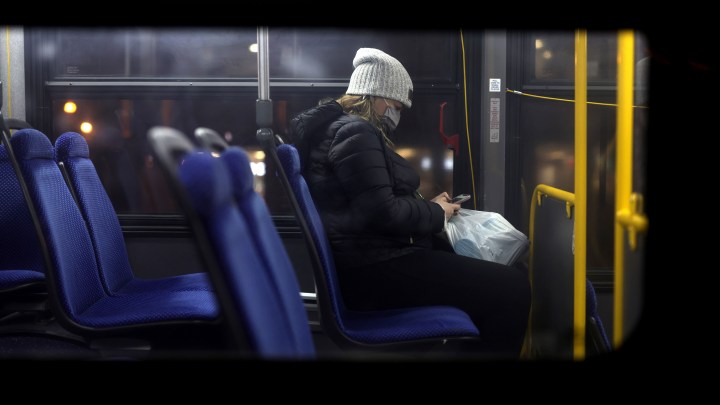
Albuquerque’s bus system starts zero-fare experiment for 2022
Albuquerque’s bus system starts zero-fare experiment for 2022

The west side of Albuquerque, New Mexico, is home to a lot of people we’ve come to know as essential workers.
“From teachers to police to fire to restaurant workers,” said Lan Sena, who represented this area in the city council during the pandemic.
I met Sena at the Central and Unser Transit Center, which she said connects a lot of west-siders to those important jobs and greater economic opportunity.
“Through our zero-fares program, they’ll have greater access to that,” Sena said.
On Jan. 1, Albuquerque started a year-long experiment: allowing everyone to use city buses — which normally cost $1 per ride — for free.
It’s following the lead of cities like Missoula, Montana, Olympia, Washington and Richmond, Virginia. Boston is next in line, with a plan to make some bus routes free in the coming year. But with more than half a million residents, Albuquerque is the largest U.S. city to experiment with zero-fare transit at this scale.
In recent years, Albuquerque’s bus system provided about 9 million rides and derived only 7% of its revenue from rider fares. During the pandemic, both numbers took a nosedive. Sena said the hope is that switching to zero-fare will get riders back on the bus and give them a financial break.
“We know that most of our riders are low income,” Sena said. “These families are really living by the penny. Some of these folks are really having to think twice about their food, about their rent.”
Folks like Steven Rios, who was waiting at the transit center for a ride home from his job at a local burger and burrito chain.
“I do make tips over there at Twisters, and that’s usually how I pay for the bus,” Rios said. “I’m trying to save up money, and I do think [zero-fare] will help me out in that sense.”
But Rios also worries the new system could make the bus less safe. “To be honest, it makes me feel kind of scared for the bus drivers,” he said.
This is a common concern when cities consider ditching transit fees: that making buses and trains more accessible will also make them magnets for crime. But in some cities, it’s had the opposite effect.
“Our incident rates on our vehicles actually went down significantly,” said Robbie Makinen, CEO of the Kansas City Area Transportation Authority, which switched to zero-fare in the early days of the pandemic.
Makinen said the most common source of conflict on city buses was disputes over rider fares, which ultimately made up just 10% of the agency’s budget.
“And what first started me down this path is, look, I’m not gonna put our operators in danger over $1.50,” Makinen said.
Plus, Makinen sees zero-fare transit as a tool to reduce crime and advance equity by connecting people in need with jobs, housing and services.
“This isn’t about just putting four tires on a street and going from A to B,” Makinen said. “You’ve gotta take the blinders off and you have got to weave yourself into the community fabric.”
More American cities are thinking about their transit systems that way, according to Robert Puentes, who heads up the ENO Center for Transportation.
“Even before the coronavirus, there were a number of transit systems that were thinking about, ‘What would happen if we didn’t charge people for using the bus and we treated it like an essential service?’” Puentes said.
The pandemic expedited that paradigm shift and created a natural experiment, with some cities putting federal relief funds toward zero-fare pilot programs.
“But that money does run out, so there are enormous fiscal cliffs coming up in a couple of years,” Puentes said.
Transit systems will have to prove to their local governments that zero-fare systems are worth keeping. Puentes said that will require them to boost ridership.
“It’s not an ‘If you build it, they will come’ kind of scenario. We’ve got to make sure the network is providing the services that people need to make it a mode of choice,” Puentes said.
That would have the added benefit of reducing vehicle emissions that contribute to climate change. In New Mexico, getting Burqueños out of their cars and onto public transit could be an uphill battle.
Julian Gonzales usually drives to work but took the bus on a recent Monday out of necessity. “It’s just that somebody else is using the car today, that’s why,” he said with a laugh.
With the zero-fare system and the rising price of gas, he said, public transit was starting to look more attractive.
“But it’s hard to get away from your automobile when you’re used to your automobile,” Gonzales said. “Back when I took the bus every day, it was because I couldn’t drive yet.”
It would take major structural improvements to get Gonzales riding the bus regularly: things like faster service, expanded routes and better security.
There’s a lot happening in the world. Through it all, Marketplace is here for you.
You rely on Marketplace to break down the world’s events and tell you how it affects you in a fact-based, approachable way. We rely on your financial support to keep making that possible.
Your donation today powers the independent journalism that you rely on. For just $5/month, you can help sustain Marketplace so we can keep reporting on the things that matter to you.











